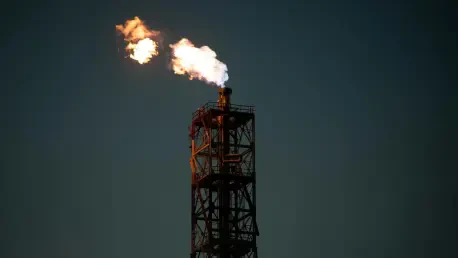A silent epidemic is sweeping across the United States, claiming an estimated 91,000 lives every year due to air pollution from the oil and gas industries. According to a groundbreaking study published in Science Advances, the pollutants released throughout the lifecycle of these fossil fuels—from drilling deep into the earth to burning fuel in vehicles—are exacting a devastating toll on public health. This alarming figure is not just a statistic; it serves as a stark reminder of the invisible danger lurking in the air millions breathe daily. The research sheds light on a crisis that transcends mere environmental concern, positioning air pollution as a critical public health emergency demanding immediate attention. Beyond the staggering number of premature deaths, the study reveals a host of other severe health impacts affecting American families across generations. As the nation grapples with these findings, the urgency to address the sources and consequences of this pollution has never been clearer.
Unpacking the Deadly Lifecycle of Fossil Fuels
The oil and gas industry leaves a toxic footprint at every stage of its operation, as revealed by comprehensive research analyzing data from 2017, the most recent year with a complete emissions dataset. From the initial exploration and extraction processes to the refining, distribution, and final consumption in homes and vehicles, each phase releases harmful pollutants into the atmosphere. Fine particulate matter, known as PM2.5, along with nitrogen dioxide and ozone, emerges as a pervasive threat, infiltrating lungs and bloodstreams with devastating effects. What makes this study unique is its holistic approach, marking the first time health impacts have been traced across the entire lifecycle. This meticulous breakdown underscores that no part of the process is benign, with each step contributing to the alarming health burden faced by communities nationwide. The pervasive nature of these emissions highlights the complexity of tackling pollution at its roots, requiring interventions at multiple points along the supply chain.
Since the data collection in 2017, the landscape of oil and gas production in the US has shifted dramatically, with production surging by 40% and consumption rising by 8%. This escalation suggests that the health impacts documented in the study may be even more severe today, as increased activity likely translates to higher emissions. The implications are sobering: without significant efforts to curb output or mitigate pollution, the toll of premature deaths and related illnesses could climb further in the coming years. This trend points to a growing public health challenge that parallels the industry’s expansion, emphasizing the need for updated data to capture the current scale of harm. Moreover, it raises critical questions about the sustainability of relying on fossil fuels when each increase in production potentially deepens the crisis. Addressing this issue will require not only technological innovation but also a reevaluation of energy policies to prioritize cleaner alternatives and reduce dependence on polluting sources.
Disproportionate Impacts on Vulnerable Populations
Air pollution from oil and gas does not affect all Americans equally, with communities of color bearing a significantly heavier burden across every stage of the industry’s lifecycle. Asian, Black, Hispanic, and Native American populations face heightened exposure to toxic emissions, whether from drilling sites in rural areas or industrial hubs near urban centers. For instance, Native American and Hispanic groups often reside near exploration and extraction zones, inhaling pollutants from the earliest phases of production, while Black and Asian communities in regions like Louisiana’s industrial corridor suffer from emissions tied to refining and manufacturing. This pattern of inequality is not new; it aligns with historical research showing that minority groups are exposed to far more pollution than they generate, in stark contrast to other demographics. Such disparities reveal a deep-seated environmental injustice that compounds existing social and economic challenges.
The human cost of this uneven exposure is evident in specific high-impact areas, often referred to as sacrifice zones due to their proximity to heavy industry. In eastern Texas and parts of Louisiana, residents live with the constant threat of health issues linked to nearby refineries and processing plants, where emissions contribute to elevated rates of respiratory diseases and other conditions. These communities, frequently marginalized and lacking the resources to relocate or advocate for change, are trapped in environments that jeopardize their well-being daily. The study’s findings reinforce the urgent need for targeted policies that prioritize protection for these vulnerable groups, addressing not just the pollution itself but the systemic factors that place certain populations at greater risk. Without deliberate action to rectify these inequities, the health disparities tied to fossil fuel pollution will persist, perpetuating a cycle of harm that disproportionately affects those least equipped to combat it.
A Global Crisis of Air Quality
Zooming out from the US, the issue of air pollution emerges as a global health emergency of staggering proportions, ranking as the second leading cause of death worldwide, just behind high blood pressure. According to the World Health Organization (WHO), approximately 7 million people die annually due to exposure to PM2.5, a pollutant that knows no borders and affects nearly every corner of the planet. Shockingly, nine out of ten individuals globally live in areas with air quality below safe standards, breathing in toxins that shave years off life expectancy and impair quality of life. The WHO’s updated air quality guidelines from 2021, which set stricter limits for PM2.5 exposure, reflect a growing scientific consensus that even minimal levels of these pollutants pose severe risks. This international perspective underscores that the challenges faced in the US are part of a much larger struggle to ensure clean air for all.
The global statistics paint a grim picture of the cumulative impact of air pollution, with PM2.5 alone linked to a loss of billions of years of life expectancy across populations. While the US grapples with its domestic crisis tied to oil and gas emissions, many other nations face similar or worse conditions, often exacerbated by industrial activity and lax regulations. The pervasive nature of this threat highlights the interconnectedness of environmental and health policies worldwide, where progress in one region can inspire or inform solutions elsewhere. For instance, adopting WHO’s stringent standards could serve as a blueprint for countries aiming to reduce mortality rates tied to poor air quality. However, achieving such goals requires international cooperation and a shared commitment to reducing reliance on polluting industries. The scale of this crisis demands a unified response, as clean air remains a fundamental right yet to be secured for the vast majority of the world’s inhabitants.
The Lethal Threat of PM2.5
Among the array of pollutants stemming from oil and gas activities, PM2.5 stands out as the most dangerous due to its microscopic size and ability to cause widespread harm. These fine particles, small enough to penetrate deep into the lungs and even enter the bloodstream, are linked to a host of serious conditions, including heart disease, lung disorders, and premature death. In the US, PM2.5 is a primary driver behind the 91,000 annual deaths attributed to fossil fuel pollution, silently affecting millions who may not even realize the air they breathe is toxic. Globally, the consensus among scientists and organizations like the WHO is unequivocal: PM2.5 represents the single greatest threat within the spectrum of air pollution, with its impacts felt across every demographic. The insidious nature of these particles makes them a public health enemy that requires focused efforts to monitor and reduce.
Reducing exposure to PM2.5 is a complex challenge, as these particles originate from numerous sources within the oil and gas lifecycle, from combustion engines to industrial processes. Their ability to travel long distances means that even communities far from production sites are not immune to their effects, complicating efforts to pinpoint and mitigate emissions. Health experts emphasize that cutting PM2.5 levels could yield immediate benefits, potentially preventing thousands of deaths and illnesses each year. However, achieving meaningful reductions demands a multi-pronged approach, including stricter emission standards, investment in cleaner technologies, and public education on air quality risks. The urgency of addressing PM2.5 cannot be overstated, as its pervasive presence in the atmosphere continues to undermine health outcomes on a massive scale. Until significant progress is made, this pollutant will remain a leading contributor to the global burden of disease tied to air pollution.
Escalating Risks with Industry Growth
The trajectory of oil and gas production in the US paints a troubling picture for future health outcomes, as industry activity continues to expand without corresponding reductions in emissions. Since 2017, consumption alone has increased by 8%, amplifying the release of pollutants into the atmosphere and likely intensifying the associated health toll. This growth in output signals a potential rise in premature deaths, childhood asthma cases, and cancer diagnoses if left unchecked. The correlation between increased production and worsening air quality is a clear warning that current practices are unsustainable, placing additional pressure on policymakers to act swiftly. Without interventions to curb emissions or shift toward cleaner energy sources, the burden on public health systems and communities will only deepen, creating a ripple effect of suffering and economic strain.
Looking ahead, the rising risks tied to industry expansion underscore the critical need for proactive measures to protect vulnerable populations and mitigate harm. Strategies such as implementing stricter regulatory frameworks, incentivizing renewable energy adoption, and enhancing monitoring of air quality near production sites could make a tangible difference. Additionally, investing in research to update health impact assessments with more recent data will provide a clearer understanding of the current crisis, ensuring that responses are tailored to today’s realities. The path forward must prioritize both immediate actions to reduce emissions and long-term plans to transition away from fossil fuel dependency. As the industry grows, so too does the imperative to balance energy needs with the fundamental right to clean air, ensuring that future generations are not left to bear an even heavier burden from decisions made today.









